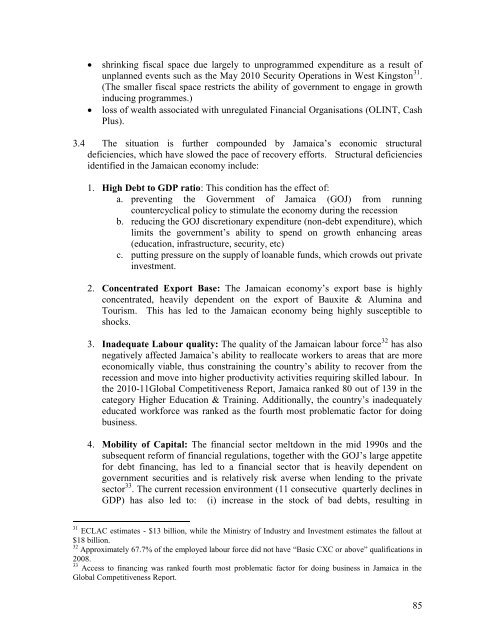PIOJ Growth-Inducement Strategy - Planning Institute of Jamaica
PIOJ Growth-Inducement Strategy - Planning Institute of Jamaica
PIOJ Growth-Inducement Strategy - Planning Institute of Jamaica
Create successful ePaper yourself
Turn your PDF publications into a flip-book with our unique Google optimized e-Paper software.
shrinking fiscal space due largely to unprogrammed expenditure as a result <strong>of</strong><br />
unplanned events such as the May 2010 Security Operations in West Kingston 31 .<br />
(The smaller fiscal space restricts the ability <strong>of</strong> government to engage in growth<br />
inducing programmes.)<br />
loss <strong>of</strong> wealth associated with unregulated Financial Organisations (OLINT, Cash<br />
Plus).<br />
3.4 The situation is further compounded by <strong>Jamaica</strong>’s economic structural<br />
deficiencies, which have slowed the pace <strong>of</strong> recovery efforts. Structural deficiencies<br />
identified in the <strong>Jamaica</strong>n economy include:<br />
1. High Debt to GDP ratio: This condition has the effect <strong>of</strong>:<br />
a. preventing the Government <strong>of</strong> <strong>Jamaica</strong> (GOJ) from running<br />
countercyclical policy to stimulate the economy during the recession<br />
b. reducing the GOJ discretionary expenditure (non-debt expenditure), which<br />
limits the government’s ability to spend on growth enhancing areas<br />
(education, infrastructure, security, etc)<br />
c. putting pressure on the supply <strong>of</strong> loanable funds, which crowds out private<br />
investment.<br />
2. Concentrated Export Base: The <strong>Jamaica</strong>n economy’s export base is highly<br />
concentrated, heavily dependent on the export <strong>of</strong> Bauxite & Alumina and<br />
Tourism. This has led to the <strong>Jamaica</strong>n economy being highly susceptible to<br />
shocks.<br />
3. Inadequate Labour quality: The quality <strong>of</strong> the <strong>Jamaica</strong>n labour force 32 has also<br />
negatively affected <strong>Jamaica</strong>’s ability to reallocate workers to areas that are more<br />
economically viable, thus constraining the country’s ability to recover from the<br />
recession and move into higher productivity activities requiring skilled labour. In<br />
the 2010-11Global Competitiveness Report, <strong>Jamaica</strong> ranked 80 out <strong>of</strong> 139 in the<br />
category Higher Education & Training. Additionally, the country’s inadequately<br />
educated workforce was ranked as the fourth most problematic factor for doing<br />
business.<br />
4. Mobility <strong>of</strong> Capital: The financial sector meltdown in the mid 1990s and the<br />
subsequent reform <strong>of</strong> financial regulations, together with the GOJ’s large appetite<br />
for debt financing, has led to a financial sector that is heavily dependent on<br />
government securities and is relatively risk averse when lending to the private<br />
sector 33 . The current recession environment (11 consecutive quarterly declines in<br />
GDP) has also led to: (i) increase in the stock <strong>of</strong> bad debts, resulting in<br />
31 ECLAC estimates - $13 billion, while the Ministry <strong>of</strong> Industry and Investment estimates the fallout at<br />
$18 billion.<br />
32 Approximately 67.7% <strong>of</strong> the employed labour force did not have “Basic CXC or above” qualifications in<br />
2008.<br />
33 Access to financing was ranked fourth most problematic factor for doing business in <strong>Jamaica</strong> in the<br />
Global Competitiveness Report.<br />
85
















